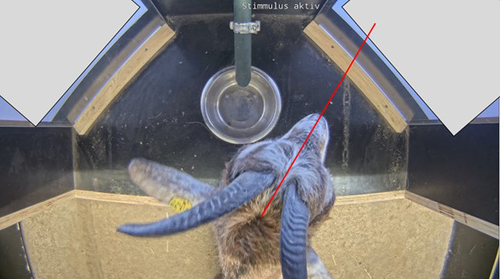
BON Richard
Recommendations: 0
Review: 1
Review: 1

Goats who stare at video screens – assessing behavioural responses of goats towards images of familiar and unfamiliar con- and heterospecifics
Gazing behaviour as a tool to study goat cognition
Recommended by Isabelle Veissier based on reviews by Richard Bon and 1 anonymous reviewerMany cognitive studies use paradigms based on active decision-making, that require that animals are motivated to participate and interested in the reward (e.g. Rivas-Blanco et al., 2023). By contrast, looking time paradigms, in which the visual attention of an animal to a stimulus is measured, requires little training and little action from the subject, and can be used without reinforcement (e.g. Wilson et al., 2023).
In this methodological paper, Jana Deutsch and her collaborators investigated the possibility of using a looking time paradigm to study perception and cognition in goats. The advantage of such a paradigm would be that it requires little training and can be used with no reinforcement. Goats were observed in front of two video screens presenting pictures of goats (familiar or not), of humans (familiar or not), or remaining white. The authors hypothesised that goats would pay more attention to pictures than to a white screen, would pay more attention to goats than to humans, and would discriminate familiar vs. unfamiliar beings. The goats had received previous positive contacts with the familiar humans. The goats were extensively habituated to the experimental set-up so that stress did not interfere in responses to testing. The stimuli were presented on the screens in a pseudorandomized and counterbalanced order.
As hypothesised, goats looked longer at screen with pictures, and longer when the picture was that of another goat (familiar or not) than of a human being. Goats however did not seem to discriminate between familiar and unfamiliar being, or were equally motivated by the two types of beings. Ear postures were also recorded but did not show a relation with looking time and were not related to the type of picture shown on screens. Therefore, the authors argue that looking time but not ear posture is considered appropriate to test discrimination abilities or preferences in goats. More studies are needed to check if goats can differentiate familiar vs. unfamiliar beings.
The experimental design is sound. The statistical analyses are rigorous and very relevant. The paper is clearly written.
I recommend the manuscript for publication for its originality and its quality; In addition, the paper bring findings – that looking time is an adequate paradigm in goats to analyse how they pay attention to stimuli – that have potential impacts on further studies in animal cognition.
References
Deutsch, J., Lebing, S., Eggert, A., Nawroth, C. (2024). Goats who stare at video screens – assessing behavioural responses of goats towards images of familiar and unfamiliar con- and heterospecifics. OSF, ver.4 peer-reviewed and recommended by Peer Community In Animal Science. https://doi.org/10.31219/osf.io/d4nzk
Rivas-Blanco, D., Monteiro, T., Virányi, Z., Range, F. (2024). Going back to “basics”: Harlow’s learning set task with wolves and dogs. Learning & Behavior. https://doi.org/10.3758/s13420-024-00631-6
Wilson, V. A. D., Bethell, E. J., Nawroth, C. (2023). The use of gaze to study cognition: limitations, solutions, and applications to animal welfare. Frontiers in Psychology, 14:1147278. https://doi.org/10.3389/fpsyg.2023.1147278